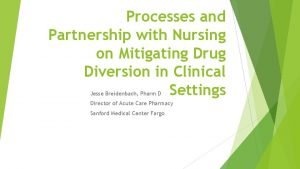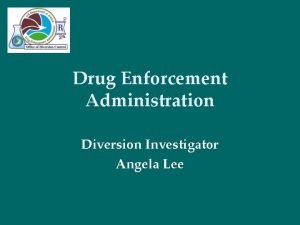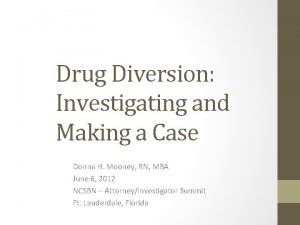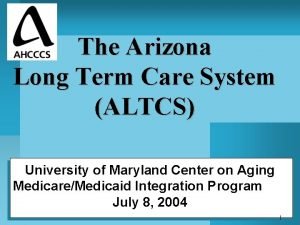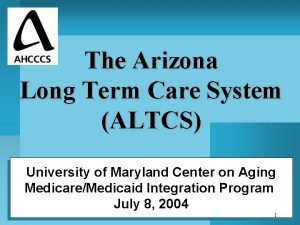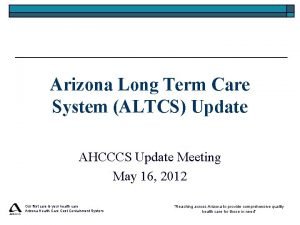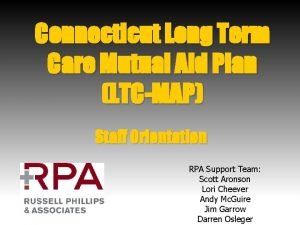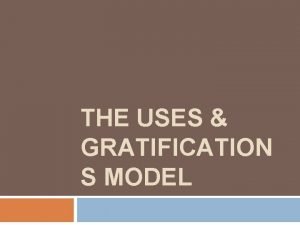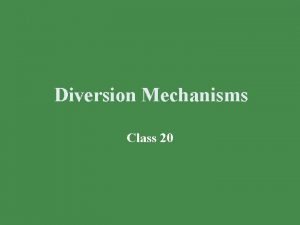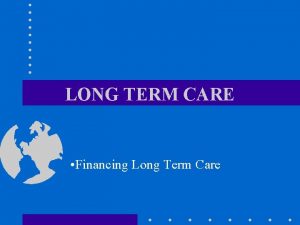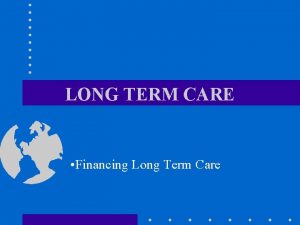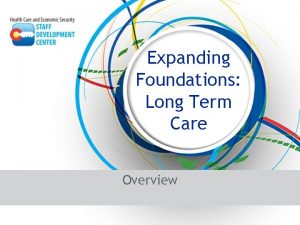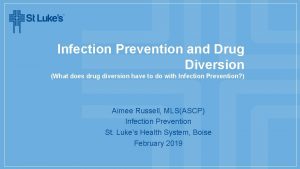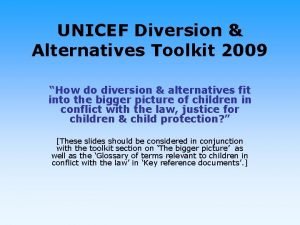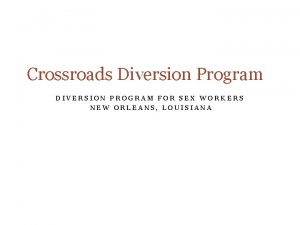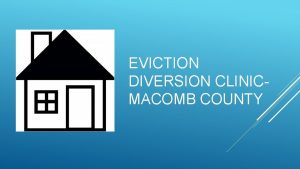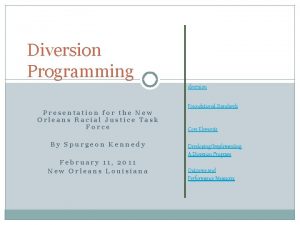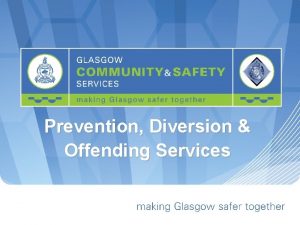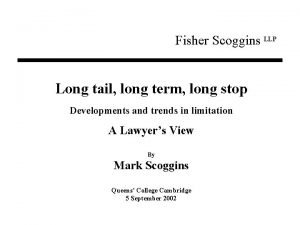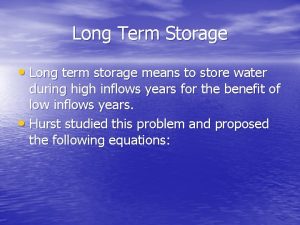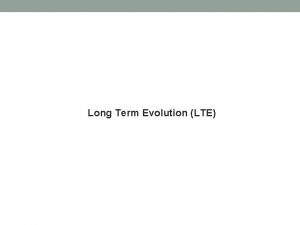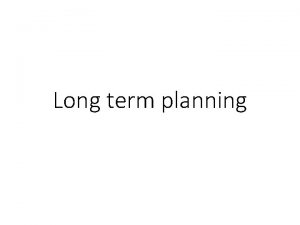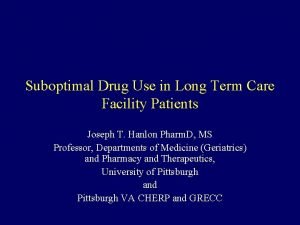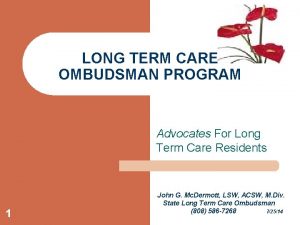Drug Diversion In Long Term Care GGara Wilsie
































- Slides: 32

Drug Diversion In Long Term Care GGara Wilsie, D. Ph. Remedi Senior. Care ROOkkla G Oklahoma City, Ok 73108

Learning Objectives • What is Diversion of drugs and why does it happen? • What are the signs to watch for? • What policy and procedures should be in place to decrease the risk of diversion? • Checklist for investigation of diversion? • Anticipated changes to prevent diversion? 2

Control Medication Diversion of drugs: Unlawful channeling of regulated pharmaceuticals, including the misuse of prescription medications • Symptom of the disease of addiction • Addiction is a treatable disease

Reasons for Diversion? • Personal use by staff • 90% of Americans struggling with addictions are not currently getting treatment • In 2016, 11. 5 million persons misused prescription opioids and 116 persons died every day from opioid related drug overdoses • Use by related person to staff • Sale of medications: Hydrocodone $3 -$7/tablet Alprazolam $1 -$5/tablet

Healthcare Professionals and Drug Abuse: Types of drugs preferred: • • • 60% use an opiate 45% use a benzodiazepine 11% use sedatives 3. 5% use amphetamines 1. 9% use inhalants Early Intervention is vital for both patient care concerns and health care employee professional recovery A visible program is a major deterrent to diversion (Lillibridge, Cox & Cross, 2002)

Drug Diversion Issues: Staff • 10 – 20% of nurses have substance abuse issues • ANA estimates approximately 6% to 8% of nurses are practicing while impaired • Substance abuse is the number one reason named by state boards of nursing for disciplinary action • Recidivism rates by nurses from diversion and rehabilitation programs are lower when compared with the general population (Griffith, 1999); (Trinkoff& Storr, 1998) (Sullivan & Decker, 2001).

Staff Risk Factors: In the workplace: • Stress • Belief in medications-back pain, headaches • Caregiver Burnout • Access to control Substances At high risk: Staff who administer drugs daily and perceive poor to non-existent workplace controls have 2 X the risk of drug misuse.

Physical Signs of Use/Withdraw • Physical signs of use or withdrawal: • • • Hand tremors Headache Diaphoresis Abdominal/muscle cramps Nausea/ Diarrhea Irritability or Restlessness • Signs may disappear with use • Non-descript: can also be signs of psychological problems. • Behaviors impair clinical judgment and put residents at risk (Smith et al. , 1998).

Drug Diversion: Staff Indicators Staff Behavioral Indicators: ü Frequently volunteers to work extra shifts “could be your best employee” ü Work the heavier care halls with the “better drugs” ü Offer to work weekends, evening, nights when management is not around ü Frequent, unexplained disappearances during shift ü Feels the need to order the medication and go after the medication.

Drug Diversion: Staff Indicators Continued ü Control medication only needed when that staff person works. ü Often shows up on days off to finish work or retrieve forgotten items ü Frequently spills or wastes narcotics ü Chaotic home/personal life ü Refuses to comply with narcotic diversion investigational procedures ü Implausible excuses for behavior or become defensive

Drug Diversion Resident Care Indicators: ü Inconsistent or incorrect charting: Narcotic sheet documentation does not match PRN sheet documentation for number of doses administered. ü Displays inconsistent work quality with times of high and low efficiency ü Offers to medicate other nurses’ patients on a regular basis

Drug Diversion Resident Care Indicators ü Care for specific residents with cognitive impairment ü His/her residents reveal consistent pain scale patterns or complain that narcotics are not effective on that shift.

Preventing Drug Diversion: Best Practices Policies, Procedures and Controls • • Procurement Storage/Security Prescribing Preparation/Administration of CDS Handling Waste Documentation Followup if diversion is suspected.

Preventing Drug Diversion: Best Practices Procurement: § Prescriber or physician agent calls pharmacy with order § Hard copy of control drug is written § Electronic copy of control drug is sent to the pharmacy Storage/Security: § Control medications should be stored separately from other medications and under double lock § Access to medication carts/medication cabinets should be limited to person passing medication and wellness director. Don’t hand over medication keys to anyone during shift. § Where are medication carts kept when not in use?

Preventing Drug Diversion: Best Practices Handling Waste: § Waste should have a documented witness Documentation: § Documentation should occur when administering not at the end of a shift. § Documentation should occur on the MAR and medication count sheet § Document pain scores at the time of administration of pain medication See it-report it! § Report discrepancies immediately § Report suspected diversion § Report inappropriate access to control medication area

Preventing Drug Diversion: Best Practices Managers: § Use proactive approach for early detection/intervention. Be observed doing documentation audits Med pass observations Med cart audits randomly § Are carts kept where they are supposed to be kept when not in use? § Are they locked at all times when out of eyesight of the person passing medications?

Preventing Drug Diversion: Best Practices Disposing of control substances: § Controlled substance receipt/reconciliation § Timely identification and removal of medication § Identification of storage method for medication awaiting final disposition § Control and accountability of medications awaiting final disposition § Documentation of actual disposition of medication § Method of destruction consistent with community policy § Procedures for discrepancies, theft/loss

When Diversion Occurs… CREATE A CHECKLIST TO INCLUDE: 1. Date/Time/Brief description of the event 2. Who is notified-Administrator/DON? What is policy for timely notification? At that time or Monday AM? 3. Discrepancy report-what is missing? 4. Medication supply/cart inspection. Suggest not only cart that count is off but all controlled drug storage areas including discontinued medications. 5. Review documentation of administration vs. count sheet

CHECKLIST FOR INVESTIGATION CREATE A CHECKLIST TO INCLUDE: 6. Review of pain monitor documentation 7. Review of ordered CDS for trends in frequency and quantities. Multiple incidents of same person ordering/receiving? 8. Are there missing count sheets? 9. Were the controls in refrigerator checked? 10. Are there VA medications not counted every shift? 11. Camera documentation? Blind spots?

CHECKLIST FOR INVESTIGATION You should consider contacting the Pharmacy- • Records of dispensing new and refill control substances for designated time frame • Copies of refill requests-who is requesting refills? • Delivery manifest of narcotics-who signed for the control medications

CHECKLIST FOR INVESTIGATION WHO DO WE NOTIFY? • Administrator/Director of Nurses • Police • OSDH-misappropriation of resident property • OSDH-Neglect/Abuse • Nurse Aide Registry (CMAs) • Board of Nursing (RN, LPN) OSDH will notify the Attorney General’s office

PROPOSED CHANGES TO PREVENT DIVERSION Control substance medications are required to be ordered electronically January 1, 2020. Many of physicians serving our communities are currently using a software called Sure Scripts to do this. Possible limits to days supply of control medications by insurance companies. Possible early refill limits-90% used prior refill

PROPOSED CHANGES TO PREVENT DIVERSION Oklahoma Health Care Authority is looking at incorporating MME (Morphine Equivalents) for all opioids into the OK Medicaid Management System. Members aggregate MME/day will be included in claims. The CDC encourages caution in doses exceeding 50 MME/day. Some states have changed the requirements for drug disposition to occur within 5 days after drug is discontinued to help prevent diversion (Ohio). Suggest look at what your community policy for destruction is and determine if adequate.

Medical Marijuana

Classification of Schedule I Drugs Schedule I Controlled Substances Federal Level: o No currently accepted medical use in the United States o Lack of accepted safety for use under medical supervision o High potential for abuse o Schedule I : heroin, LSD, marijuana, peyote, ecstasy State Level: Varies by state, 30 states have approved to date Physicians cannot ‘prescribe’ medical cannabis because prescriptions are regulated under the CSA Physicians can ‘recommend’ or ‘certify’

Maryland Health Dept Action April 2018

New York Department of Health Oct 2017 Emergency Regulations allow Nursing Homes and Assisted Living Residences to be among the “designated caregiver facilities” under the state medical marijuana program. Such facilities may see DOH approval to become a registered designated caregiver for a certified patient in the medical marijuana program. Finally, the regulation also clarified that designated caregivers, including employees of designated caregiver facilities, are protected against arrest, prosecution, penalty, or disciplinary action by professional licensing board or bureau.

Medical Cannabanoids Legal Under Federal Law FDA Approved Marinol (Dronabinol)- THC (N/V, Anorexia) Cesamet (Nabilone)- THC analog (N/V) Awaiting NDA Submission Epidiolex (Cannabidiol)- Cannabidiol/CBD (Seizures) Sativex (Nabiximols)- THC+ CBD (Pain, spasms in MS)

CBD Oil? OK Health Department Comments DEA 21 CFR Part 1308 Federal Register/Volume 81, No 240/90194 -12/14/16

REASONS TO ADDRESS DIVERSION NOW Security of our facilities, staff and residents! Our residents deserve to receive their prescribed medications and have their health conditions treated appropriately.

Thank You

References Narcotic Use and Diversion in Nursing Mandy L. Hrobak, University of Arizona College of Nursing http: //juns. nursing. arizona. edu/articles/Fall%202002/hrobak. htm. 1. 2. Nurse Drug Diversion and Nursing Leader's Responsibilities: Legal, Regulatory, Ethical, Humanistic, and Practical Considerations. Tanga, H. JONA's Healthcare Law, Ethics, and Regulation Jan 2011 Vol 13(1) pg 13 – 16. http: //www. nursingcenter. com/lnc/static? pageid=1193263. 3. Impaired healthcare professional Marie R. Baldisseri, MD, FCCM. Crit Care Med 2007 Vol. 35, No. 2 (Suppl. ) http: //www. csamasam. org/sites/default/files/pdf/misc/16_article_Baldisseri_Impaired_healthcare_prof_2007. pdf. 4. A Multidisciplinary Approach to Proactive Drug Diversion Prevention. Jerry Siegel Pharm. D. FASHP The Ohio State University Medical Center Columbus, Ohio, 2009.
 Drug diversion in nursing homes
Drug diversion in nursing homes Drug diversion investigation checklist
Drug diversion investigation checklist Diversion investigator
Diversion investigator Investigating and making a case for drug diversion
Investigating and making a case for drug diversion Wv pdmp
Wv pdmp Short medium and long term planning in education
Short medium and long term planning in education Long term memory vs short term memory
Long term memory vs short term memory Long term hr planning
Long term hr planning Difference between long term and short term liabilities
Difference between long term and short term liabilities Long term liabilities
Long term liabilities Example of short term goal
Example of short term goal Short term financial management
Short term financial management Short short short long long long short short short
Short short short long long long short short short Once upon a time,there
Once upon a time,there Wisconsin long term care partnership program
Wisconsin long term care partnership program Altcs arizona long term care
Altcs arizona long term care What is altcs
What is altcs Ahcccs altcs
Ahcccs altcs Mutual aid plan ct
Mutual aid plan ct Example of crude drug adulterated with exhausted drug
Example of crude drug adulterated with exhausted drug Primary secondary tertiary care nursing
Primary secondary tertiary care nursing Dbd diversion
Dbd diversion Trade diversion and trade creation
Trade diversion and trade creation Diversion uses and gratification
Diversion uses and gratification Trade diversion and trade creation
Trade diversion and trade creation The juvenile justice and welfare act of 2006
The juvenile justice and welfare act of 2006 Trade diversion and trade creation
Trade diversion and trade creation Cross drainage works
Cross drainage works Diversionary principles
Diversionary principles Trade diversion and trade creation
Trade diversion and trade creation Upper lobe diversion
Upper lobe diversion Liaison and diversion interview questions
Liaison and diversion interview questions Judge robert tejeda
Judge robert tejeda

